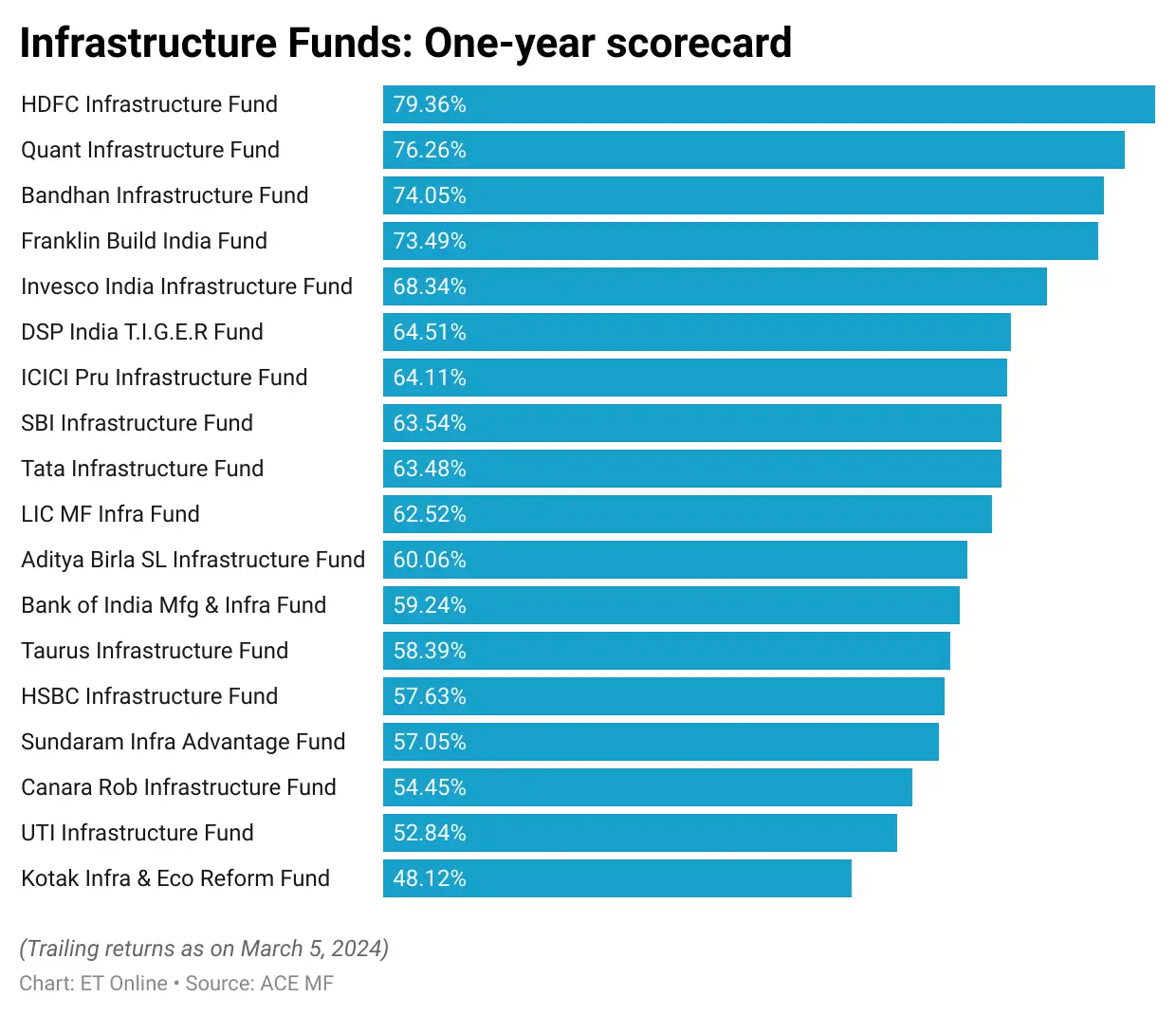Toppers offered more than 70% in a one year horizon. HDFC Infrastructure Fund, the topper in the category, offered 79.36% in one year. Quant Infrastructure Fund offered 76.26%. Bandhan Infrastructure Fund and Franklin Build India Fund gave 74.05% and 73.49% respectively.
 ETMarkets.com
ETMarkets.comICICI Prudential Infrastructure Fund, the largest scheme in the category based on assets managed, offered 64.11% in one year. UTI Infrastructure Fund, the oldest scheme in the category, offered 52.84% in the same time period.
Also Read | Rs 7 lakh crore of mutual fund money riding on shoulders of 42 women fund managers
Now, how did the infrastructure funds manage to offer such high returns? What contributed to this success? “The growth in infrastructure funds has been primarily due to the present Government’s focus and push on infrastructure. This financial year there was a spending outlay of Rs 10 lakh crore which was a 37% increase over the previous year. India is well-positioned to be the third-largest economy in the next 3 to 4 years,” said Rajesh Minocha, a Certified Financial Planner (CFP), Founder of Financial Radiance.
He added, “With the tax collections (direct and indirect) going up significantly, the Government has put a lot of focus on infrastructure as that also directly or indirectly helps many other industries that will help India to achieve GDP growth in the next few years. However, infrastructure funds performance should be looked at with a longer time horizon and not just within the last few years.”
Infrastructure funds offered the second highest return in a three month, and three year horizon. The category in a three month and three year horizons gave an average return of around 16.81% and 31.23% respectively. Quant Infrastructure Fund offered the highest return of around 31.80% in three months, followed by Bandhan Infrastructure Fund which offered 20.73%.
Quant Infrastructure Fund remained the topper in the three year horizon as well. The scheme offered 43.87%, followed by ICICI Prudential Infrastructure Fund which offered 38.04%.
These schemes are majorly benchmarked against Nifty Infrastructure – TRI and S&P BSE India Infrastructure Index. Nifty Infrastructure – TRI and S&P BSE India Infrastructure Index gave 64.18% and 107. 50% respectively in one year horizon.
Also Read | 36 equity mutual funds doubled investors wealth in three years
However, looking at the current performance and average returns by the infrastructure funds, and getting excited about making investments, what strategy should one follow?
“Investors need to be alert and careful and not just invest in infrastructure funds just because they have done well in the last couple of years. The asset allocation of their portfolio should be based on their goals, time horizon, and risk appetite and not only on performance,” recommends Minocha.
“Taking exposure through diversified funds is a better strategy as a good fund manager can take purchase and exit calls on infrastructure-related companies in the portfolio. If an investor wants to take exposure directly, it should be only a tactical move as part of the satellite portfolio and not the core portfolio, constituting only 5 to 7% of the total portfolio allocation,” he adds.
Infrastructure funds are meant for investors with a high risk tolerance. Thematic or sector schemes invest most of their corpus in a particular sector, and the performance of schemes is based on performance of the sector. That is why thematic or sector funds are recommended only to investors with thorough knowledge about the sector.
You should invest in these schemes only if you have a long investment horizon or have intimate knowledge about the sector to time the entry and exit in these schemes. Remember, every sector or theme can go out of fashion depending on the economic conditions. You should not make hasty decisions in those phases.







